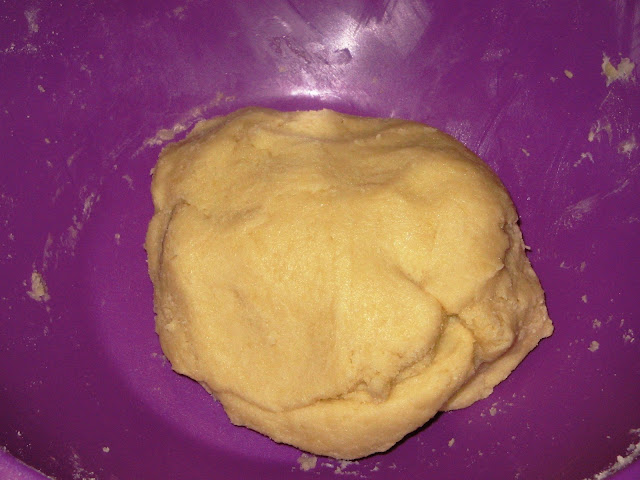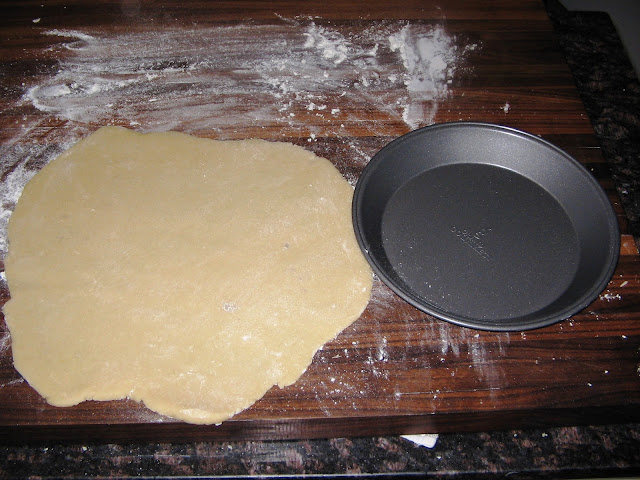I had three recipes left in the pastry section of the Basics chapter, and all three were pie/tart crusts so I decided to try all three in a head-to-head battle. The core ingredients were all the same, with each recipe either omitting or adding one item. Below are the ingredients necessary for the Sweet Pastry Dough (page 32), the Basic Pie Dough (page 34), and the Rich Sweet Pastry Dough (page 34).
Ingredients were measured out using my usual methods.
Going in order, I began with the Sweet Pastry Dough. The flour, superfine sugar, and salt were sifted together and placed in a mixing bowl. This was followed by the addition of the egg and butter.
The directions tell you to use your fingertips to mix everything together until it reaches a "grainy" stage.
The addition of just a little bit of ice-cold water brings everything together into a supple dough.
The dough has to rest for at least an hour in the fridge, so I started up the second recipe, the Basic Pie Dough. The method was the same, except that it replaced the egg with sunflower oil.
I got to the grainy stage, added the water, and formed my dough.
That went into the fridge, and I started the third recipe, the Rich Sweet Pastry Dough. This one had a slightly different approach. The egg and superfine sugar go into the bowl first.
These are whisked together until the sugar is dissolved.
After stirring in the vanilla extract, the flour and salt were sifted on top of the mixture.
Once again, we get to the grainy stage.
In the previous two recipes, the butter was softened before being mixed into the dough. In this one, however, the butter is to remain cold while being diced and added. I remembered watching an episode of Good Eats with Alton Brown where he used a box grater to handle the butter. I figured I would give that a shot.
It seemed to work pretty darned well!
The dough came together just like the previous two, and it was ready for the fridge.
From left to right, we have the same order as I made them. I had two pie pans and a tart pan, so I went with those. The first and third doughs were to be cooked at 375 degrees, so I decided to make them together. The middle dough had to bake at 400, so I did that one last.
The Sweet Pastry Dough was rolled out to a size that would accommodate both the bottom and sides of the pie pan.
Looks good to me!
The pie crust needs to "set" during the first half of the baking so that it doesn't poof up or bubble too much. To prevent this, add a sheet of parchment paper on top.
You can buy fancy ceramic pie weights for a lot of money, or you can spend less than a buck and use dried beans.
The Sweet Pastry Dough and the Rich Sweet Pastry Dough were ready for the oven!
The pie crusts sit in the oven for ten minutes with the weights, and during this time you can develop your exit strategy for the weights. I went with my super oven mitts and a large bowl.
After ten minutes, I pulled the weights, and this is what they looked like.
After the weights are removed, you have to bake for an additional ten to fifteen minutes. As this was an experiment, I pulled them out after ten minutes, documented, and placed them back in for an additional five minutes. Here is the Sweet Pastry Dough after twenty total baking minutes.
Here is the Rich Sweet Pastry Dough at the same point in time.
Five minutes of additional baking later, here is the Sweet Pastry Dough.
Here is the Rich Sweet Pastry Dough as well.
I cranked up the oven to 400, and while it was coming up to temperature I started to make the Basic Pie Dough. This was the biggest pain by far. This dough absolutely REFUSED to hold itself together.
Even if you manage to roll out all the cracks, you had to eventually pick it up somehow to place it in the pie pan. No matter what technique I tried, nor how carefully I attempted this, the dough just fell apart. Upon reflection, this was the recipe that omitted the egg, which can act as a binding agent in a dough.
Even as a ball of dough, just a slight twist of the wrist would cause the entire ball to rip in half. This was a terrible dough.
So it was time for a new approach. Picking up the dough was impossible once rolled out, so I tried rolling out the dough while already in the pan.
Using just my hand wasn't working too well, so I used a small glass to make everything smooth.
The "weights" were added just like the previous two recipes, and after ten minutes I attempted to remove the parchment paper. This dough was so terrible that a good chunk of it came with the parchment paper.
I was fed up with this recipe, so I didn't bother much with the research. I just pulled it after the additional ten minutes.
Clearly, overbrowning on the edges is going to be an issue, but a manageable one.
The crusts were all cooled and tasted by The Bride and me, and we had the same conclusions. The Rich Sweet Pastry Dough was our favorite. The only things separating the two recipes were the addition of vanilla extract and method of mixing. This recipe also had the firmest crust of the three. The Sweet Pastry Dough also proved itself quite viable for use in future recipes. It tasted great, was fairly flaky, and seemed like it would be able to be put to good use. Finally, not only was the Basic Pie Dough a royal pain to work with, it tasted awful. If I am asked to use it in the future, I just may substitute one of the other two.
The pastry doughs are done, and tomorrow I start frostings and fillings!
The crusts were all cooled and tasted by The Bride and me, and we had the same conclusions. The Rich Sweet Pastry Dough was our favorite. The only things separating the two recipes were the addition of vanilla extract and method of mixing. This recipe also had the firmest crust of the three. The Sweet Pastry Dough also proved itself quite viable for use in future recipes. It tasted great, was fairly flaky, and seemed like it would be able to be put to good use. Finally, not only was the Basic Pie Dough a royal pain to work with, it tasted awful. If I am asked to use it in the future, I just may substitute one of the other two.
The pastry doughs are done, and tomorrow I start frostings and fillings!

































I never did get along with pie crusts; they win every time...so, I either buy the crust or buy the pie. About the only one I can handle is the good old graham cracker deal, which to be honest, probably doesn't qualify!
ReplyDelete